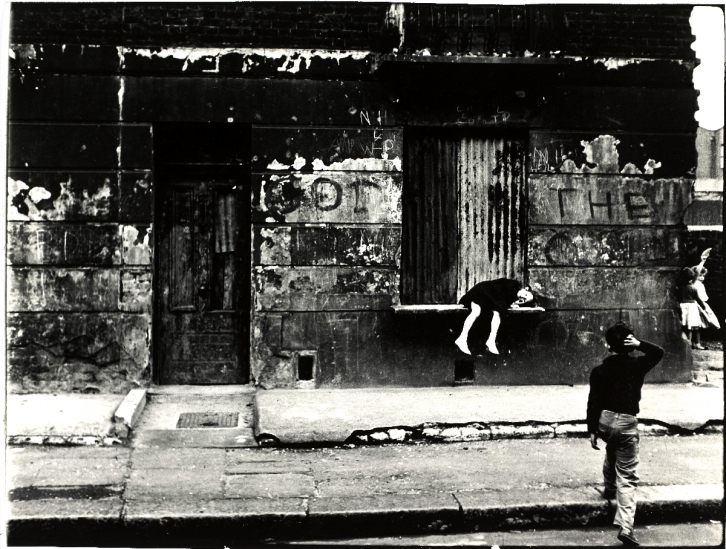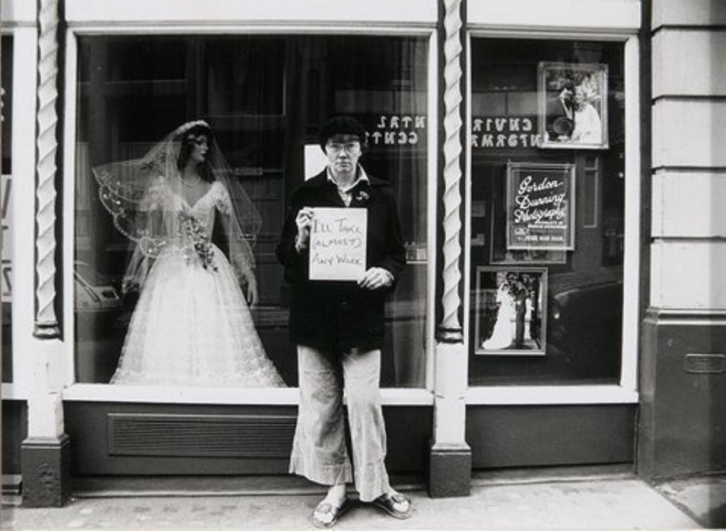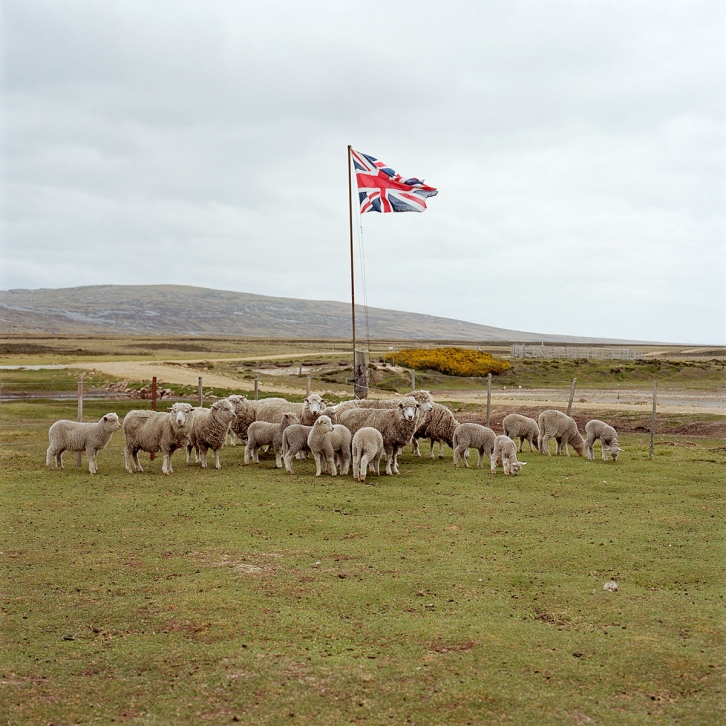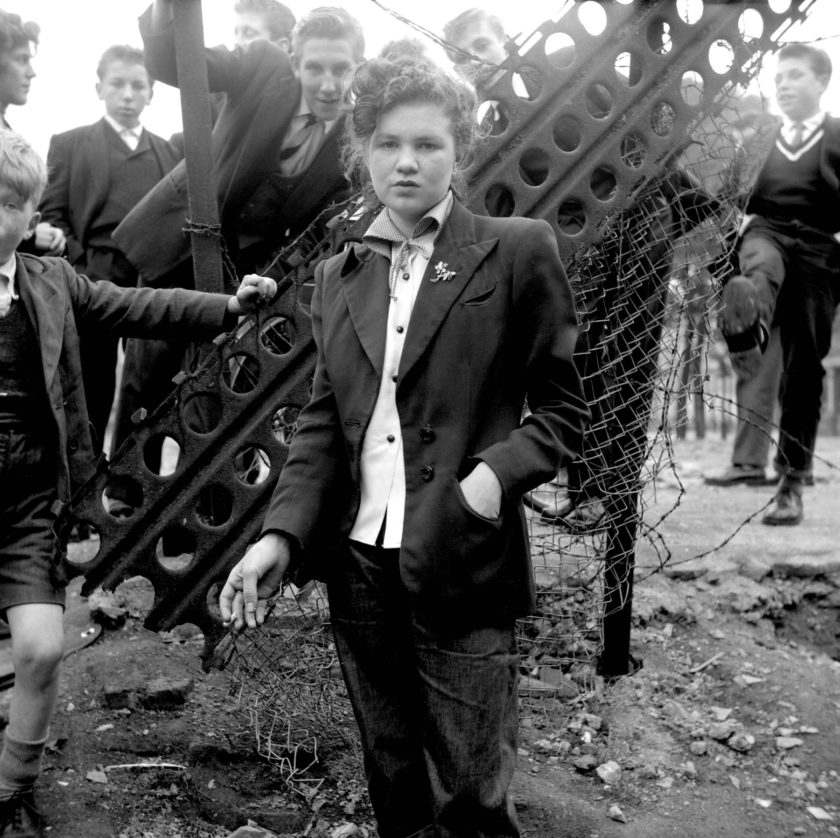Photographs Worth a Thousand Words
From Londonhua WIKI
Photographs Worth a Thousand Words
by Justine Roy
 Justine Roy |
Contents
- 1 Photographs Worth a Thousand Words
- 2 Abstract
- 3 Introduction
- 4 Section 1: Background
- 4.1 London, Air Raid Shelters, East End Underground Station, November 12th, 1940
- 4.2 God Save the Queen (Hampden Crescent, Paddington)
- 4.3 The Highest Product of Capitalism (After John Heartfield)
- 4.4 Resort 2, Fairy with Cigarette, 2009
- 4.5 A Gather of Sheep, Long Island Farm, from Empire
- 4.6 In Your Dreams
- 5 Section 2: Deliverable
- 6 Conclusion
- 7 References
- 8 External Links
Abstract
The purpose of this project is to explore how photography is used as a form of communication, reflecting on the social and political conditions of the time. I will be selecting a few photographs that reflect British culture and will analyze how the photographer captures the subject and conveys his/her message to the viewer. To achieve this, I will also tie in historical background as needed. This project will provide breadth beyond my theater concentration.
Introduction
I suggest you save this section for last. Describe the essence of this project. Cover what the project is and who cares in the first two sentences. Then cover what others have done like it, how your project is different. Discuss the extent to which your strategy for completing this project was new to you, or an extension of previous HUA experiences.
As you continue to think about your project milestones, reread the "Goals" narrative on defining project milestones from the HU2900 syllabus. Remember: the idea is to have equip your milestone with a really solid background and then some sort of "thing that you do". You'll need to add in some narrative to describe why you did the "thing that you did", which you'd probably want to do anyway. You can make it easy for your advisors to give you a high grade by ensuring that your project milestone work reflects careful, considerate, and comprehensive thought and effort in terms of your background review, and insightful, cumulative, and methodical approaches toward the creative components of your project milestone deliverables.
PLEASE NOTE: this milestone template has only a few sections as examples, but your actual milestone should have many relevant sections and subsections. Please start to block out and complete those sections asking yourself "who, what, when, where, and why".
Remember, as you move toward your creative deliverable, you're going to want/need a solid background that supports your case, so you want it to paint a clear and thorough picture of what's going on, so that you can easily dissect your creative component and say "This thing I did is rooted in this aspect of my background research".
Section 1: Background
Photography can be a powerful outlet and tool. People can use it as a coping tool or a way to get their voice out. The British Journal of Photography recounts multiple instances of photography being used to adjust to a new environment, gain new understanding or speak out. David Gaberle took up photography after moving to London and struggling for a while. Now he travels internationally, capturing the essence of major cities. [1]Spencer Murphy gained new insight into the dirt biker subculture. He no longer sees them as reckless criminals but as a community of individuals seeking freedom from mundane life. [2] In recent years the British Journal of Photography has launched a new yearly campaign to showcase British culture and what it means to live in the United Kingdom called Portrait of Britain through creating a collection of professional and amateur photographs. Such photographs join ranks of photographs from throughout history that are treasured for the story they tell about British society. The Hyman Collection was created to share such material and contains iconic photographs from throughout the United Kingdom's history to modern day. I have chosen several photographs from this collection as well as some from collections featured in the British Journal of Photography to analyze the message the photographs are telling.
London, Air Raid Shelters, East End Underground Station, November 12th, 1940
 | |
| London, Air Raid Shelters, East End Underground Station, November 12th, 1940 [3] | |
|---|---|
| Artist | Bill Brandt |
| Year | c. 1940 |
| Dimensions | 25.1 x 19.5 cms (9.86 x 7.66 ins) |
| Location | Private Collection |
Context
This photograph was taken on November 12th, 1940. This was about 10 days prior to the end of the Blitz. The Blitz was one of the major events in World War II for Britain. In early September of 1940, Hitler was aggravated at Britain's dominance over Luftwaffe and the bombing of German cities. In order to save face, the head of Luftwaffe, Hermann Goering, decided to change tactics and launch an air raid on Britain. His goal was that the bombings would destroy public moral and draw out all of Britain's forces to be destroyed. Instead, the shift of focus from attacking military bases gave the British the opportunity to strengthen their forces and gave the soldiers a stronger cause to fight for, the lives of their families and friends. The air raids lasted for 76 days. Bombs were dropped day and night. The bombs decimated infrastructure and left fires ravaging London. Similar raids were also held against Bristol, Manchester, Swansea, Liverpool, Cardiff, and Southampton.[4]
Analysis
This photograph captures the hardships that people had to go through during the Blitz. It depicts people sleeping in a metal shelter underground. People are packed together and have few personal belongings. All that can be seen are blankets and a few jackets. The photograph highlights a mother with her children. This heightens the emotional impact as women and children are traditionally seen as innocent and more vulnerable. The photographer uses perspective in this photograph to increase the drama. The vanishing point makes it appear as if this scene continues on for a ways.
God Save the Queen (Hampden Crescent, Paddington)
 | |
| God Save the Queen (Hampden Crescent, Paddington) [5] | |
|---|---|
| Artist | Roger Mayne |
| Year | c. 1957 |
| Dimensions | 58.4 x 78.5 cms (22.95 x 30.85 ins) |
| Location | Quaritch, London |
Context
"God Save the Queen" was taken in 1965. The 1960s were a period of great change for Britain. The country was coming back from World War II with the rise of the baby boomers. Culture changed as this generation, whose parents wanted them to have it better than they did during the war, took full advantage of their freedom. Recreational drugs such as LSD became a part of culture. [6] The Beatles ushered in a new generation for music that broke down some of the social barriers. They made pop music and pop culture acceptable to multiple classes of people. [7] Miniskirts were introduced as the new fashion for women and feminism grew. [8] Several key events occurred in 1965 including the death of Winston Churchill, implementation of legislation against racial discrimination and abolition of the death penalty. [9] [10] The last event is significant for the reason that it diminished the power of the government. Roy Jenkins was elected into office who would later legalize abortion and homosexuality. People responded very differently to this change and still have differing opinions to this day.[11]
Analysis
This photograph appears to portray a negative perspective on all the change that is taking place. First of all, the building is run down showing a state of decay. The sidewalk is crumbling. Secondly, the kids are supposed to be the future of the people and are part of the generation bringing about all the change. However, one kid is just laying down on the window sill of the abandoned building. Even the kids who should be full of energy, are run down. Perhaps most significantly, there is graffiti on the building saying "God Save the Queen". Within that statement, two symbols of tradition are called forth. The first is religion. Religion has had very strong roots in the country as England had a whole civil war over their official religion. The second symbol is the Queen. The monarchy is an establishment that continues today even though primarily only for the sake of tradition. The writer of the graffiti clearly felt as though such institutions and traditions were being threatened by the changes taking place in the country. As the person wanted the queen "saved" there is no doubt that the changes were seen as negative.
The Highest Product of Capitalism (After John Heartfield)
 | |
| The Highest Product of Capitalism (After John Heartfield) [12] | |
|---|---|
| Artist | Jo Spence |
| Year | c. 1979 |
| Dimensions | 20.32 x 25.4 cms (7.99 x 9.98 ins) |
| Location | Jo Spence Memorial Archive Richard Saltoun Gallery, London |
Context
This photograph was taken during a period of feminist movements. Some of the changes brought about by this movement include the passage of the Equal Pay Act, Sex Discrimination Act and Domestic Violence Act as well as the formation of the Women's Aid Federation. [13] While significant milestones had been reached towards female rights, women continued protesting for further equality. Photographer, Jo Spence participated in the movement. Spence came from a working-class family, started off as a professional photographer and then shifted her focus to political photography. [14] This photograph was modeled off another photograph, "Spitzenprodukte des kapitalismus"[15] by John Heartfield, taken in 1932. Heartfield was also a political photographer during the early 1900s and opposed Hitler. [16] "Spitzenprodukte des kapitalismus" addressed the gap in classes as a man seeking work stood next to a mannequin bride wearing a pricey dress. [17]
Analysis
There appear to be multiple similar themes in this photograph. The sign says "I'll take (almost) any work". This could be indicating a struggle for women to get employment at the time despite the progress being made towards women's rights and equality. Furthermore, the original photograph by John Heartfield called attention to the gap in classes. This could be functioning the same way in Spence's photograph but in regard to the lack of equality between men and women. It is also interesting that Spence chose to cross dress when recreating this image. The image of her cross dressed may symbolize that there is no real difference between her as a female and a man. This would further the idea that women deserve the same rights.
Resort 2, Fairy with Cigarette, 2009
 | |
| Resort 2, Fairy with Cigarette, 2009 [18] | |
|---|---|
| Artist | Anna Fox |
| Year | c. 2009 |
| Dimensions | 73.66 x 91.44 cms (28.95 x 35.94 ins) |
Context
Modern British culture is largely one of acceptance. In 1967, homosexuality was legalized. In 1979, Margaret Thatcher became Britain's first female prime minister.[19] This acceptance is reflected in modern entertainment. In 2011, Doctor Who, a popular British family show, introduced a couple that was both lesbian and interspecies. In 2014, the couple kissed. While 6 complaints were filed to the television regulator, the audience response was largely positive. [20] In addition, the National Theater's production of "Twelfth Night" by William Shakespeare features several gender swapped characters and gay relationships. This is in contrast to the United States where gay marriage was only just legalized in 2015 and people who identify as other than heterosexual still face mistreatment. Another notable difference seen in British culture is the amount of smoking people still do. While smoking cigarettes has largely taken on a social stigma in the United States, it appears to still be fairly widely done in the UK.
Analysis
This photograph is all about contrast. It defies stereotypes. The clashing elements of a man dressed as a fairy who is smoking clearly shows that people do not fit into simple classifications. The man is big and bald yet dressed in a stereotypically pink and girly outfit. The sight of the man smoking goes against the idea of childhood innocence invoked by the fairy costume. Even the bright pink costume stands out against the darker and blue surroundings. However, the casual nature of the photograph tells the viewer that it is ok. The man does not appear to care, nor does anyone else around him, therefore neither should the viewer. In such a way, the photograph promotes diversity, individuality and acceptance.
A Gather of Sheep, Long Island Farm, from Empire
 | |
| A Gather of Sheep, Long Island Farm, from Empire [21] | |
|---|---|
| Artist | Jon Tonks |
| Year | c. 2014 |
| Dimensions | 101.6 x 101.6 cms (39.93 x 39.93 ins) |
Background
In 2014 there were a couple of major political shifts and events. Most significant was the vote on Scottish independence. The result was 55% of people chosing for Scotland to remain in the United Kingdom and 45% wanting independence. Another shift in the politics was an increase in support for the UK Independence Party. This party held anti-European Union sentiment. [22]
Analysis
The image of the sheep gathered around the flag is a very patriotic image. In the Bible, Jesus is depicted as a shepherd with Christians being his sheep. Likewise, the sheep symbolize the British people. The British flag represents the United Kingdom. The sheep are gathered around the flag as the people stand by their country. Within the sheep there are young and old just as citizens of all ages feel patriotism towards the country. This sentiment resonates with the political climate that year. The vote, while divided, for Scotland to remain part of the United Kingdom is an example of the people standing by the country as opposed to leaving it. The image may also be suggestive towards those people who wanted independence. It can be sending the message to follow along like a sheep would, stay a part of the herd and stay with the country. In addition, the increased support for a party against the European Union also meant an increase in support for national autonomy. In the case of the American colonies, this desire for autonomy was linked to the people strongly identifying with their colony. They believed strongly in their own colony and did not want interference from others. Likewise, this can indicate a similar loyalty in the British people to their country and way of life. Therefore, the image also reflects this renewal of patriotism.
In Your Dreams
 | |
| In Your Dreams [23] | |
|---|---|
| Artist | Ken Russel |
| Year | c. 1955 |
Context
The Teddy Boys and Girls were the first youth subculture in Britain. They existed in the early 1950s post World War II. Having grown up in the war, they were tough. With the war being over they had more time for leisure than the previous generations. These youth came from the working class. Their style drew on Edwardian fashion, giving them a bit of a refined look. In part, they were asserting their importance in the class divided society. Despite their outward appearance, these kids were rebellious. While not as much is documented on Teddy Girls, Teddy boys were despised by adults. Most carried weapons and many committed violent crimes and vandalism in order to assert dominance and claim territory. They quickly became associated with the crime in the city. However, these youths also embodied the new vitality coming back to the city as they embraced their freedom.[24]
Analysis
This photograph captures the culture of the Teddy Boys and Girls. The focus of the picture is a Teddy girl. She appears to have quite an attitude as she looks defiantly at the camera. Meanwhile, some of the boys in the background peer mischievously at the camera. This is consistent with their rebellious behavior. This impression of their boldness is heightened by the camera angle. An upward angle is said to give a sense of power to the subject. Likewise, the slight upward angle towards the kids shows their power in society. They were the next generation and shaping the culture. Their violent and criminal activities could also impact people's lives powerfully. In addition, the photo shows the style of the Teddy girl as the primary subject is wearing the typical blazer with jeans.
Section 2: Deliverable
Red Buses
"Double Decker" and "Passenger" capture several iconic images associated with London. The focus of the pictures is on the classic double-decker buses. These buses are closely associated with London culture. It would be difficult for a visitor to London not to see one as they are all over the streets. They are also a symbol of the public transportation system as a whole. Public transportation is a large part of living in the city as there is limited room for cars. In London it is particularly glorified. It seems odd that something as common as public transportation would have its own extensive line of merchandise but it does. It is also raining in the pictures showing the notorious rainy weather of the United Kingdom. "Passenger" has some additional elements. First of all, it was taken from the perspective of a bus passenger. This was done to give a more personal and immersive feel. Secondly, there is a sticker that someone left on the window. The shape of the sticker is the standard transit logo, again showing its pervasiveness. The sticker says "#HopeNotHate". This little sticker displays the open culture that has been created in the country and the belief in acceptance. It is a little bit of positivity amidst all the chaos that the city can be. Finally, I made some artistic modifications to the photographs. I changed the photographs to black and white aside from a few colors. I preserved the bold and iconic red as well as blue and yellow. The red and blue comprise the transport logo and call attention to it as a focus of the pictures. The yellow is used on the buses and for the emergency exit sign, again drawing attention to common but integral parts of the buses. The red is predominant in the pictures to focus on the buses. It is also a bit symbolic. Not only is the red significant because it is the color of the buses but it is the color of the telephone boxes.
Big Issue of Homelessness
Here I want to photography images associated with homelessness in the city as it is considered the big issue. I have not gotten the photos yet.
My Photograph 3 Name
here I will include my photograph and an explanation of what it portrays, why I chose the theme, why I chose to portray it the way I did
Conclusion
In this section, provide a summary or recap of your work, as well as potential areas of further inquiry (for yourself, future students, or other researchers).
References
- ↑ D'Aliesio, S. (2017). Photobook: Metropolight by david gaberle. British Journal of Photography, Retrieved from http://www.bjp-online.com/2017/04/photobook-metropolight-by-david-gaberle/
- ↑ Hamilton, R. S. (2017). Wheelies, balaclavas and broken bones: Welcome to UK BikeLife. British Journal of Photography, Retrieved from http://www.bjp-online.com/2017/05/wheelies-balaclavas-and-broken-bones-welcome-to-uk-bikelife/
- ↑ Brandt, B. (1940). London, air raid shelters, east end underground station, november 12th, 1940. Private Collection: Private Collection.
- ↑ Germany bombs london. Retrieved from http://www.bbc.co.uk/history/events/germany_bombs_london
- ↑ Mayne, R. (1957). God save the queen (hampden crescent, paddington). Quaritch, London:
- ↑ Watson, K.The 1960s the decade that shook britain. Retrieved from http://www.historic-uk.com/CultureUK/The-1960s-The-Decade-that-Shook-Britain/
- ↑ Morris, I. (2014). 1965: The year modern britain was born review – analysis of a revolution. The Guardian, Retrieved from https://www.theguardian.com/books/2014/apr/28/1965-year-modern-britain-was-born-review
- ↑ Watson, K.The 1960s the decade that shook britain. Retrieved from http://www.historic-uk.com/CultureUK/The-1960s-The-Decade-that-Shook-Britain/
- ↑ 1965: New UK race law 'not tough enough. Retrieved from http://news.bbc.co.uk/onthisday/hi/dates/stories/december/8/newsid_4457000/4457112.stm
- ↑ Britain:1945 to present. Retrieved from http://www.bbc.co.uk/history/british/timeline/present_timeline_noflash.shtml
- ↑ Morris, I. (2014). 1965: The year modern britain was born review – analysis of a revolution. The Guardian, Retrieved from https://www.theguardian.com/books/2014/apr/28/1965-year-modern-britain-was-born-review
- ↑ Spence, J. (1979). The highest product of capitalism (after john heartfield). Richard Saltoun Gallery, London: Jo Spence Memorial Archive.
- ↑ Shrew. Retrieved from http://www.bl.uk/learning/histcitizen/21cc/counterculture/liberation/shrew/shrew.html
- ↑ WILSON, S. (2015). Art labor, sex politics; feminist effects in 1970s british art and performance University of Minnesota Press.
- ↑ Heartfield, J. (1932). Spitzenprodukte des kapitalismus
- ↑ Blumberg, N.John heartfield Encyclopaedia Britannica, inc.
- ↑ WILSON, S. (2015). Art labor, sex politics; feminist effects in 1970s british art and performance University of Minnesota Press.
- ↑ Fox Anna. (2009). Resort 2, fairy with cigarette, 2009
- ↑ Britain:1945 to present. Retrieved from http://www.bbc.co.uk/history/british/timeline/present_timeline_noflash.shtml
- ↑ Williams, K. (2014). Doctor who: Lesbian kiss in series 8 debut will not be investigated by ofcom. Wales Online, Retrieved from http://www.walesonline.co.uk/whats-on/whats-on-news/doctor-whos-lesbian-kiss-not-7684850
- ↑ Tonks, J. (2014). A gather of sheep, long island farm, from empire
- ↑ United kingdom profile - timeline. (2017). Retrieved from http://www.bbc.co.uk/news/world-europe-18028620
- ↑ Russel, K. (1955). In your dreams
- ↑ Bell, A. H. (2014). Teddy boys and girls as neo-flâneurs in postwar london. Literary London: Interdisciplinary Studies in the Representation of London, 11(2) Retrieved from http://gateway.proquest.com/openurl?ctx_ver=Z39.88-2003&xri:pqil:res_ver=0.2&res_id=xri:ilcs-us&rft_id=xri:ilcs:rec:abell:R05202533
External Links
If appropriate, add an external links section